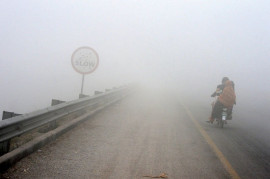
The army says it has zero tolerance for this kind of behaviour and is investigating the issue. If the veracity of the video is established, the men will be punished. Last time an army major was found involved in murdering some villagers in Sindh, he was dismissed from service and sentenced to death.
The army also says the Taliban are known to make and doctor videos. Also, the last time they attacked the GHQ, they were wearing army uniforms and one could not tell them apart from genuine soldiers.
Assumption two: The video shows army jawans bringing six men to an unidentified location and line them up. While these men are being led to the spot where they are shown to be killed, one can hear birds chirping and then a voice saying, “Tanvir saab, 2IC [second-in-command] saab bula rahay hain.” Apparently, Tanvir saab doesn’t hear him and this man then calls out and says, “Abid, Tanvir saab ko bulao; 2IC saab bula rahay hain.” Army lingo, this.
The jawans are in battle fatigues with flak jackets and helmets, holding G-3s, the standard-issue assault rifle of the army. To anyone who has seen the army from close quarters, it is hard to believe that this is a set-up, given the soldiers’ movements and mannerism.
After the men have been lined up, a soldier, presumably an officer, inspects them. He is bearded and without a moustache. He returns to the line of soldiers who straighten their rifles; one hears G-3 shots. The men fall; two soldiers walk up to the bodies and pump single rounds. One tries to fire and the rifle produces the distinct click of an empty magazine. Since he seems to be using a standard G-3 magazine, he has fired at least 20 FMJ (full metal jacket) rounds until that point.
Assumption three: this has happened, not because the army has a policy to execute Taliban fighters or suspects, but because in an operational environment where there is no front and no rear and where the enemy cannot be identified, fighting takes its toll and a unit or a sub-unit can succumb to such pressures.
It is a fact, perhaps not well-known, that Taliban groups have slaughtered captured officers and jawans on camera and sent those videos to the units. Those videos are not for the squeamish. It is only human for a fighting unit to cross the line that separates killing someone in a fire-fight and murdering fighters or suspects in cold blood to avenge the brutal killings of comrades-in-arms. (By the way, the current operational tenure is about 22 months, a terribly long time for any unit.)
But this is precisely the slippery slope the army must be worried about. The cost in terms of the psychological makeup of a fighting unit, its discipline, its approach to problem-solving, and a multitude of other factors, far outweighs the benefit of executing Taliban fighters in this manner.
In Book Three of History of the Peloponnesian War, Thucydides writes in detail about the Mytilenian Dialogue. The account, which deals with the debate over whether Athens should execute the people of Mytilene, after their revolt captures with great incisiveness the moral and ethical dilemmas and confusions that dog a people during times of war and conflict.
Pakistan has been in a state of war for nine years. And this war, for the most part, is an insurgency involving some elements of Pakistani society pitted against the state. The ethical questions for us are even more troublesome. So far, we have not even begun to debate them in any nuanced manner. And the army remains the most closed.
It is crucial for the army to openly and transparently investigate this video and, if it is found to be genuine, to proceed against the officers and men involved for murder. And it is the task of the media and the society to debate these issues without losing the many nuances that underlie them.
Published in The Express Tribune, October 4th, 2010.
















1734778885-0/Untitled-(10)1734778885-0-270x192.webp)

COMMENTS (35)
Comments are moderated and generally will be posted if they are on-topic and not abusive.
For more information, please see our Comments FAQ